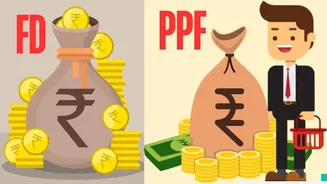PPF: Know the Rules
A Public Provident Fund (PPF) is a popular, government-backed savings scheme in India known for its tax benefits and long-term investment approach. However,
using a PPF as loan collateral comes with limitations. While it is possible to take a loan against your PPF, there are stringent rules and restrictions. For instance, you can typically only borrow after a specific number of years, often after the first year. The loan amount is usually capped at a percentage of the PPF balance, and the interest rate charged is often slightly higher than the PPF interest rate itself. The primary objective of PPF is to build a retirement corpus, thus, it is not primarily designed to serve as a readily accessible source of funds. Borrowing against a PPF can be a practical option if you need funds, but it requires careful consideration of the terms and conditions involved and the overall impact on your long-term savings goal. Keep in mind that premature withdrawals might be penalized with interest charges or affect your tax benefits, so understanding all aspects before proceeding is crucial.
FDs: Flexible Collateral Option
Fixed Deposits (FDs) offer greater flexibility when used as loan collateral. Banks and financial institutions readily accept FDs as security, making them an accessible option for those needing immediate funds. Unlike PPF, there is usually no waiting period to use your FD as collateral. You can obtain a loan quickly based on the FD amount, providing quicker access to cash. The loan amount usually depends on the FD value, often up to a high percentage of the deposited amount. The interest rate on a loan against an FD is generally more attractive compared to other types of loans. Typically, it is only slightly higher than the FD's interest rate. Moreover, FDs maintain their interest earnings, ensuring you continue earning on your initial investment even while using the FD as collateral for a loan. This combination of accessibility, favorable terms, and continued interest accrual makes FDs a versatile and appealing choice for leveraging savings to meet financial needs.
Interest Rates and Costs
Understanding interest rates and the associated costs is vital when choosing between PPF and FD for loan collateral. Loans secured by PPF generally carry interest rates slightly higher than the PPF's interest rate. This cost difference must be considered when evaluating the overall expense of borrowing. On the other hand, loans against FDs often come with competitive interest rates, often marginally higher than the FD’s interest earnings. This can make them a cost-effective choice, as you retain most of the returns from your initial investment while using it as collateral. Beyond interest rates, it is also important to consider additional fees such as processing charges and any penalties for late payments. Examining the terms and conditions associated with each type of loan will help you to determine the overall cost of borrowing and make a well-informed decision that suits your financial needs.
Tax Implications Explored
Both PPF and FD have different tax implications which is crucial to understand before using either as loan collateral. The PPF offers significant tax benefits, including tax deductions on contributions under Section 80C of the Income Tax Act, and tax-free interest accrual and maturity amounts. When you take a loan against your PPF, the interest you pay on the loan is generally not tax-deductible. While the loan does not trigger any immediate tax implications, it is essential to remember that any interest gained on your PPF will remain tax-free. Fixed Deposits also come with specific tax implications. The interest earned from FDs is taxable at the individual's applicable income tax slab rates. If you utilize an FD as collateral for a loan, the loan itself does not have direct tax implications. However, the interest on the loan is not tax-deductible. Always consult a financial advisor for personalized tax advice.















